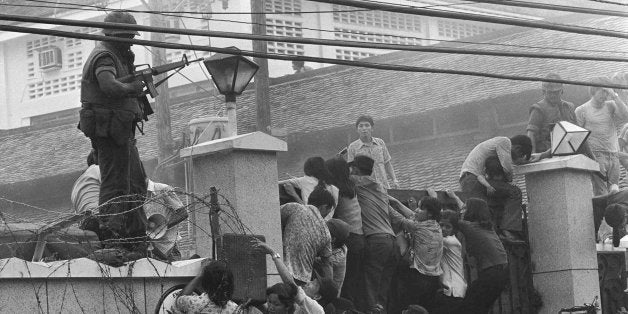
I was looking at some old pictures I took -- old enough to be Kodachrome color slides -- when I was assigned to cover a visit by Vice President Hubert Humphrey to Vietnam. He was sent by President Lyndon Johnson to meet with the American-backed leaders of South Vietnam, Generals Thieu and Ky, and to proceed to other Asian capitals to drum up support for the Vietnam War. At a farewell ceremony at Saigon's Tan Son Nhat air base, a banner proclaimed, "See You Again In Victory."
The "Mission Accomplished" banner on the flight deck of the aircraft carrier, USS Abraham Lincoln, was more professionally designed, when President George W. Bush in 2003 welcomed the crew back from the Persian Gulf and said major combat operations in Iraq were ending.
President Johnson himself went to Saigon in December, 1967, and I watched him tell the troops he was sure they would "nail the coonskin to the wall," save South Vietnam from Communism, and thereby save the neighboring countries from falling like dominoes. He stopped over in Thailand, then flew to Rome for a meeting with Pope Paul VI, who received him reluctantly.
After President Richard Nixon announced that the U.S. military would end combat operations and limit their mission to training Vietnamese troops, the North Vietnamese hung back and waited out the final American withdrawal. They and their fifth column in the South, the Viet Cong, were highly motivated, notably by the desire to kick the foreigners out, the American forces as they had the French.
I spent three months in the ABC Saigon Bureau in 1971, coming not from the States but from Moscow. An election was in progress. Vietnam had some 30 newspapers, all but one complaining that the voting was rigged, quite a contrast with the press in Soviet Russia. Students at the university debated as though they were in Berkeley. Why were the Americans in their country? There must be oil reserves offshore.
In early 1975, based in Tokyo, I was assigned to take a camera crew for a fresh look at Vietnam. What we saw was a somnolent country where American aid had created a middle class of teachers and government employees and office workers for a handful of foreign companies. You could see them on Sundays taking their families on their motor scooters on outings to the zoo. A local theater staged a Moliere comedy. We filmed a story on everyday life there, and after it aired, the New York anchor, Harry Reasoner, asked how many more years would the newscast send a crew to update the story.
The answer turned out to be less than one half of one year, when the North Vietnamese staged their final blitzkreig and their Russian-built tanks soon rolled into the presidential palace lawn in Saigon. As was the case years earlier when the communists took over North Vietnam, refugees streamed south ahead of the tank columns. The news pictures of helicopters taking evacuees from the roof of a U.S. Embassy residence building were beamed around the world.
In fact, the evacuation of American and other foreign personnel and Vietnamese employees had been going on for some days, ferrying thousands of people out of the country. The three American television networks chartered a plane to take their Vietnamese cameramen, translators, office workers, and their extended families to safety. The U.S. Embassy was slower to move -- to concede that the cause was lost and it had to get people out. So numbers of Vietnamese staffers wound up in communist "re-education" camps. I wrote then that it was better for a Vietnamese to have worked for the Bank of America than for the United States of America.
The evacuees headed to Clark Air Force Base in the Philippines, then to Guam. Their American employers set up help desks, joined by charitable organizations sponsoring their emigration to the United States. The networks placed their staff cameramen in Los Angeles and Washington bureaus, and got their part-timers jobs at affiliated stations.
And for days, months, years to come, Vietnamese piled into leaky boats to sail away from their benighted country to wherever they could start new lives.
Now, once again, American military officers in Iraq and Afghanistan -- as well as private organizations -- are clamoring to get U.S. visas for their local translators and staffers, who face far worse retaliation than "re-education" from their fanatic enemies.
Now, once again, a U.S. administration needs allies to forestall the spread of a nasty ideology with dogged armed forces threatening neighboring countries one after another, the bad guys again motivated to kick the foreigners out. And many people in the world are prepared to believe that whatever ill wind blows across their countries, it's because the all-powerful Americans are causing it.
As for the rulers of Vietnam (and Laos, and even worse, Cambodia), they won their American war and lost their economies. While most of East Asia prospered incredibly, the countries of Indo-China followed their communist precepts for a quarter century and slow walked economically. Only recently have they begun to encourage limited entrepreneurship and investment, and Vietnamese exiles -- including boat people -- who prospered in the United States and Europe are among the investors.
Vietnam also fought a border war against China, and is now joining its neighbors to ask American support against a resurgent China. And the Russians are again sending tanks into neighboring countries and daring America and Europe to do something about it.
What goes around, comes around. Unfortunately.